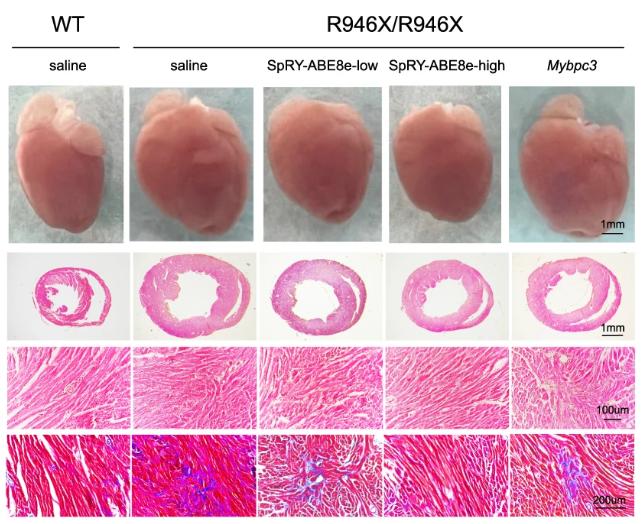Recently, researchers from Shanghai Jiao Tong University in China published a paper titled "Base editing effectively prevents early-onset severe cardiomyopathy in Mybpc3 mutant mice" in the journal Cell Research. This study developed an effective, PAM sequence-extended dual AAV vector-delivered adenine base editor-SpRY-ABE8e, which can effectively and precisely correct Mybpc3 gene mutations in mouse models, thereby preventing cardiac hypertrophy and dysfunction in mouse models. These trial results demonstrate the great potential of base editing as a new treatment modality for inherited cardiomyopathies and lay the foundation for future clinical applications.
In order to evaluate the potential of base editing to treat cardiomyopathy caused by homozygous mutations in the MYBPC3 gene that lead to premature stop codons, the research team used CRISPR-Cas9 gene editing technology to construct a Mybpc3R946X/R946X mouse model (Mybpc3 c.2836 C>T mutation). The mouse Mybpc3 protein terminates prematurely at amino acid position 946, similar to the R943X mutation of the human MYBPC3 gene. This mouse model has no detectable Mybpc3 protein in its cardiomyocytes and suffers from a cardiomyopathy with key features similar to those seen in patients with truncating mutations in the human MYBPC3 gene.
| Cat.No. | Product Name | Price |
|---|---|---|
| CSC-DC009968 | Panoply™ Human MYBPC3 Knockdown Stable Cell Line | Inquiry |
| CSC-SC009968 | Panoply™ Human MYBPC3 Over-expressing Stable Cell Line | Inquiry |
| AD10376Z | Human MYBPC3 adenoviral particles | Inquiry |
| LV18909L | human MYBPC3 (NM_000256) lentivirus particles | Inquiry |
| CDCR245899 | Mouse Mybpc3 ORF Clone(NM_008653.2) | Inquiry |
| CDFR006222 | Rat Mybpc3 cDNA Clone(NM_001106490.1) | Inquiry |
| MiUTR1H-06554 | MYBPC3 miRNA 3'UTR clone | Inquiry |
| MiUTR1M-07422 | MYBPC3 miRNA 3'UTR clone | Inquiry |
To correct the Mybpc3 c.2836 C>T mutation, the research team used an adenine base editor (ABE), which catalyzes the base conversion of A·T to G·C. The research team used SpRY-ABEmax, which can target the target site.
The research team verified the in vitro editing efficiency of SpRY-ABEmax in embryonic fibroblasts of the Mybpc3R946X/R946X mouse model for the first time. Since SpRY-ABEmax has low editing and repair efficiency for Mybpc3 mutations, the research team further developed SpRY-ABE8e with higher editing efficiency. Since the size of SpRY-ABEmax exceeds the delivery limit of adeno-associated virus (AAV), the research team used a dual AAV vector delivery strategy.
The research team used a dual AAV9 vector to deliver SpRY-ABE8e and used a cardiomyocyte-specific cTnT promoter to ensure its expression in cardiomyocytes. The study also used two different doses (0.5 × 1014 vg/kg, 1 × 1014 vg/kg) to determine the therapeutic effect and dose-response relationship.

Figure 1. Schematic diagram of the dual AAV-SpRY-ABE8e system. (Wu S, et al., 2024)
After 6 months of treatment, high-dose SpRY-ABE8e introduced an average of 9.56% A>G transitions at the target, compared with 4.64% at low-dose. Since cardiomyocytes account for ~25%-35% of cardiac cells, the editing efficiency of high-dose SpRY-ABE8e in cardiomyocytes is estimated to be ~30%. The research team observed low bystander editing activity, and high-dose SpRY-ABE8e induced very low editing frequencies in the liver, lung, spleen, and quadriceps muscle, indicating that the treatment is cardiomyocyte-specific.

Figure 2. Representative anatomic images of AAV-SpRY-ABE8e- and AAV-Mybpc3-treated hearts 6 months post-injection. (Wu S, et al., 2024)
Unexpectedly, high-dose SpRY-ABE8e treatment restored 78%-110% of MYBPC3 protein expression, and low-dose SpRY-ABE8e treatment restored 38%-70% of MYBPC3 protein expression, both of which were higher than the repair rate of gene mutations. The team theorized that this difference could be due to increased transcriptional activation or protein stability in the repaired cells.
The research team also used the same dose of AAV-Mybpc3 as high-dose SpRY-ABE8e to treat Mybpc3 R946X/R946X mice, and AAV-Mybpc3 treatment only restored 41.4% ± 4.6% of MYBPC3 protein expression. Therefore, base editing has greater potential than gene replacement to restore MYBPC3 protein expression in neonatal stage Mybpc3R946X/R946X hearts. Cardiac function testing in mouse models further confirmed this, showing that high-dose base editing provided significantly better therapeutic effects than AAV-Mybpc3, demonstrating the greater potential of base editing as a strategy to prevent cardiomyopathy.
In summary, this study constructed a transgenic mouse model carrying a truncating mutation of the human MYBPC3 gene. This model develops early-onset severe cardiomyopathy and rapidly evolves into cardiac dysfunction, a key characteristic of patients with human biallelic MYBPC3 gene truncating mutations. This study further developed an effective, PAM sequence-extended dual AAV vector-delivered adenine base editor-SpRY-ABE8e, which can effectively and precisely correct Mybpc3 gene mutations in mouse models, thereby preventing cardiac hypertrophy and dysfunction in mouse models. These trial results demonstrate the great potential of base editing as a new treatment modality for inherited cardiomyopathies and lay the foundation for future clinical applications.
Reference
Wu S, et al. Base editing effectively prevents early-onset severe cardiomyopathy in Mybpc3 mutant mice. Cell Research, 2024: 1-4.

